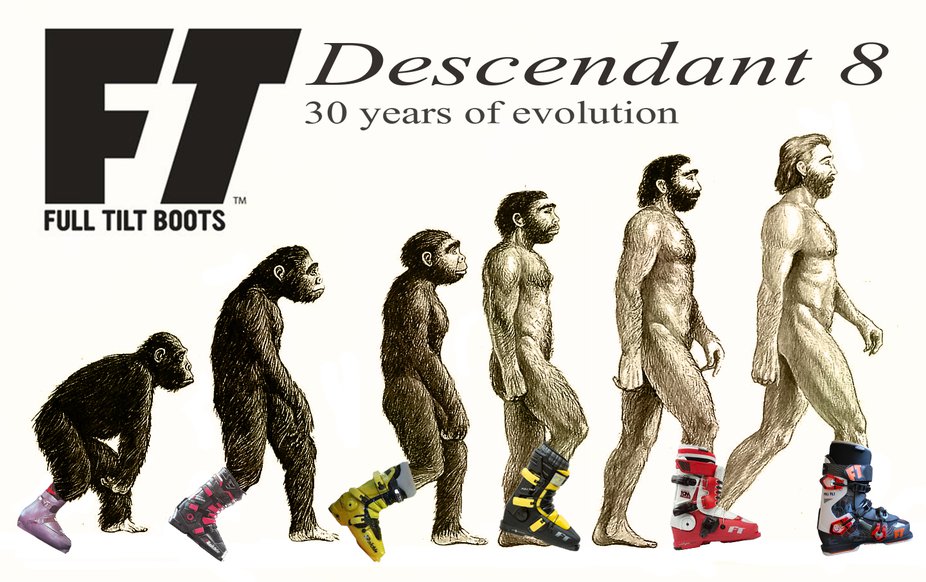
The new Evolution Shell is a big deal for full tilt. It represents the first real development of the original Flexon Design in 30 years. The Original shell from Full Tilt, although having small updates to bring it up to date was essentially the same boot Raichle made 25 years before. The Soul shell, used on the Seth and Wallisch pro models, again updated the original design but kept most of the original idea's and when a boot already works well why would you change it.
The problem Full Tilt always had was however great the original shell was it only represented one fit, and as we all know having a boot which does not fit can ruin your day. A temporary solution was found with the influence shell. Full Tilt were able to license an existing wider 3 piece boot mold from Roxa which they used for the cuff and the shell of the influence boot. They developed an all new tongue and slightly changed the cuff to keep the Full Tilt heritage in the boot but Full Tilt themselves admit the Influence boot was not perfect, being 3–1 lasted was a big issue, and it was really only ever a stop gap until they could develop their own wider boot.
But before I get to the boots, this being a brand new boot from Full Tilt I thought it may be interesting to look back at how it all started.
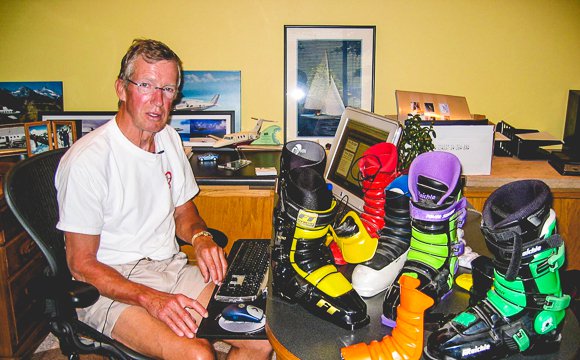
Eric Giese was one of the driving forces in getting the original Flexon to market
Most people know the story of how the Flexon boot came into existence. A small design firm in Aspen employed two scientists who had done work for NASA developing articulated sections for space suits, they used this knowledge and developed an articulated tongue for a ski boot which was successfully pitched to Raichle.
That is the shortest and to be honest worst description of how the Flexon came to be but if you want to know more Full Tilt have an awesome history page here.
There was a period in the late 90's and early 2000's it seemed the Flexon may be gone for good but in 2004 K2 bought the molds to the original Flexon boot. At the time many expected K2 to bring the boot back but for a few years nothing happened. That was until in 2006 K2 purchased Line Skis and Jason Levinthal was introduced to the K2 family.
Jason Levinthal
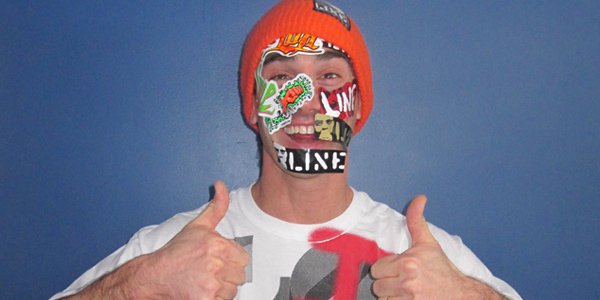
I'm sure most of you know Jason from Line and of course now J-Skis but what you may not have been aware of is without Jason Full Tilt boots may never have happened. To try and get some info on how it all went down I emailed Jason and being the awesome person he is he got straight back to me saying to give him a call and he will give me the full story. So in his own words this is how Full Tilt came to be.
Jason: In 2006 we sold line to K2 and my first trip out to K2 was an introduction to the company and that first day the president of K2, Robert Markovitch said "hey I want to show you something".
He and Paul Bennet an engineer at K2 showed me plain black boot with no logo's and said "what do you think of this boot?"
"Oh yeah that is the Raichle Flexon, I used to ride those I love that boot" I responded and Robert said "well we want to bring this boot to market"
The problem was no one at K2 at the time wanted to do it as it was seen as an old boot. At the time the people making the decisions saw it as an old boot and no one would buy an old boot. It was also thought that for the first boot K2 produced it should be a new design and not something "old".
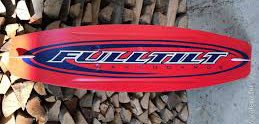
So instead what Robert proposed was selling the boots under an old existing Wake Board brand K2 owned, called Full Tilt. K2 already owned all the global trademark rights to Full Tilt so they wanted to combine the name Full Tilt with the original Flexon molds and have me bring a boot brand to market.
I immediately jumped at the opportunity. At that point I had only been involved with Line and I wanted to show that I could apply what I knew about marketing and branding to more then just one ski brand.
There was however somewhat of a catch, I was told by K2 "we don't have any money to put into this. Your resources for this project will be whatever you have from Line" so marketing budgets, sales budgets even the staff which were already in place had to be shared and there would be no additional investment from K2.
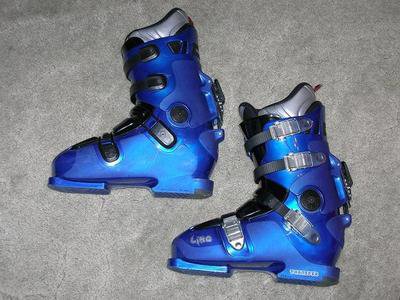
The Line Transfer boot was an early indication of what Jason wanted to do
At line I did try things with a boot idea, I felt that there was a need for a boot more suitable to the kind of skis I was making and the Line Transfer boot was the result. It was more of a case that it was the best I could do at the time, I could use the existing molds (Raichle Freeflex) and did not have to invest heavily. I felt they worked well for freestyle and was close to what was needed but it was not quite perfect.
The challenge starting out with Full Tilt was everyone saw it as a 25 year old boot, so first I had to convince the dealers that this boot should come back.
The first thing I did was jump on a plane and fly to Aspen to meet with Eric Giese one of the original inventors of the Raichle Flexon. What I realized after talking with Eric was this was not an old boot it was the "Original 3 Piece" boot. This was key as I now knew how I could market it.
This was not an old boot, yes it has been around a long time but so have overlap boots. Eric called the boots 3 piece and I said "wait this is a 3 piece? What is everything else?" "Overlap" he said. Suddenly I realized we were something different and this meant we would not have to be competing with overlap. We were different and this was the big message, we were not necessarily better or worse we were different.
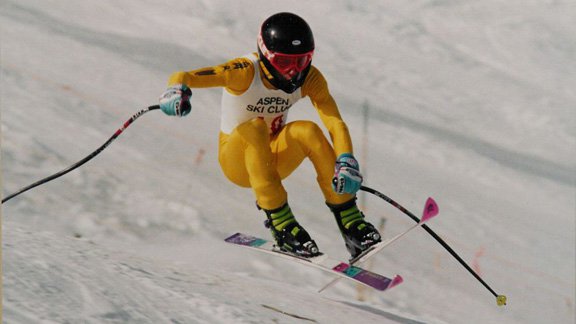
Its amazing to think Seth is using pretty much the exact same Boots and Bindings today. His skis have changed a little.
After speaking to Eric I traveled to Breckenridge to speak to Seth Morrison. Seth pulled 20 boxes out from his basement full of boots and spare parts and he said to me, "I cant ski without this boot, I need them". It was at this point I realized, ok its not just me who wants this boot the athletes want and need it too.
I knew there was a need for this product now I had to communicate the message that this was the original and best but also bring it up to date somewhat. I didn't want to change the boot I wanted to update it but for the most part we were using the original 25 year old molds and that was because the design still worked better then anything else.
With the Boot finalized I basically decorated them. I wanted to do things no other boot company was doing graphic wise and on every possible level to set Full Tilt apart. The athletes were coming to us because the boots just worked for what they were doing and this along with the unique graphics really helped us in the early days.
Jason Left Full Tilt in 2013 but he left them in a strong position as arguably one of the top boots brands in the world. Luckily though the development did not stop when he left.
Descendant Boots
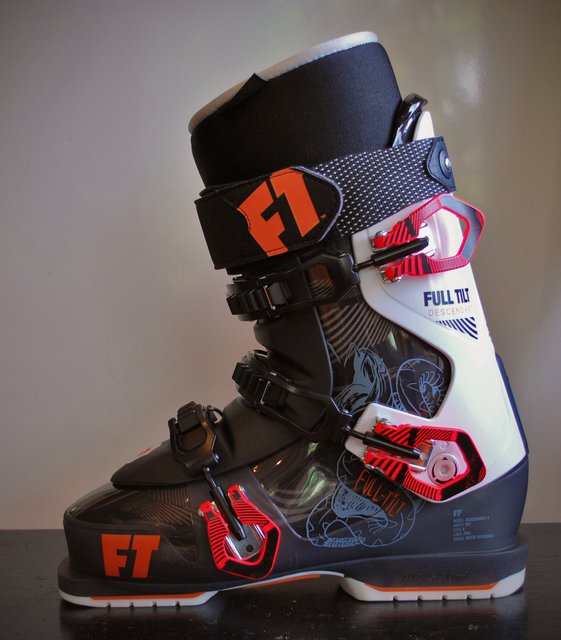
The Descendant Line of boots from full tilt for the first time offers a wider fit from a boot developed completely by Full Tilt. There are 3 men's boots and 2 woman's boots ranging from 4 – 8 in stiffness (a 10 tongue will be available) and at 102mm for the last they offer a significantly larger fit then the 99mm last used on the Original and Soul boots. They also have a number of developments but underlying everything are the key elements which make Full tilt boots so attractive; the progressive flex from the tongue and the lack of shell distortion when flexing.
The progressive flex is all thanks to the tongue and it's ridged design. In an overlap boot the cuff has to flex over the shell and at the point the cuff hits the top of the shell the flex will stop instantly. On a full Tilt boot the way the tongue can bend when flexing gives the boots a really progressive flex, feeling softer at the start and firming up gradually.
The lack of distortion in the shell when the boots are flexed is again achieved by controlling the flex with the tongue. In an overlap boot the cuff is usually bolted or riveted to the shell to help stiffen the flex. When you flex an overlap boot the lower shell will bulge slightly as the cuff compresses the shell. On a 3 piece boot the cuff is not bolted to the cuff and is free to flex over it, by doing so the lower shell is not put under so much load and does not bulge like an overlap boot will. This lack of shell distortion helps gives the boots a consistent lateral (sideways) feel even even heavily flexed forward.
Although the original Flexon DNA is certainly present Full Tilt have addressed a number of slight problems found on the Original and Soul boots.
These boots are quite easy to spot and a lot of people asked me about them while testing. It seemed everyone had there own review of Full Tilts (you should be adding those to the review system here) and although nearly everyone raved about the flex a lot of people also complained about breaking buckles.
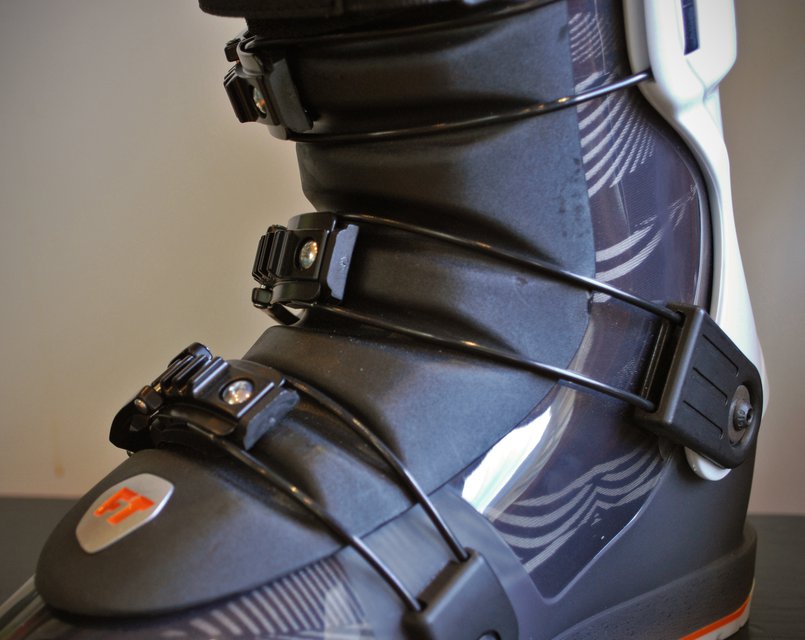
On the Original and Soul boots a cable passes all the way across the tongue and is secured by a buckle on the shell. The cables helps give the unrestricted flex so this was certainly something Full Tilt wanted to keep on the Descendant but to address the buckle problems they have changed the way the cables and buckles work on the Descendant.
Instead of passing across the foot the cable now extends about half way and a set of buckle teeth are attached to the end of the cable. These teeth sit on top of one of the ridges so as to not restrict the tongue from flexing. A traditional buckle is then mounted to the shell and this latches onto the buckle teeth on top of the tongue.
Personally I think this is a good approach, you don't want to lose the unrestricted flex of the tongue achieved by using cables but adding more sturdy buckles makes a lot of sense. The buckles are no longer mounted on a track to adjust, as multiple teeth and micro adjustment on the buckle offers all the adjustment you will need. The top and middle cable can also be moved with the top having three different available positions and the middle two.
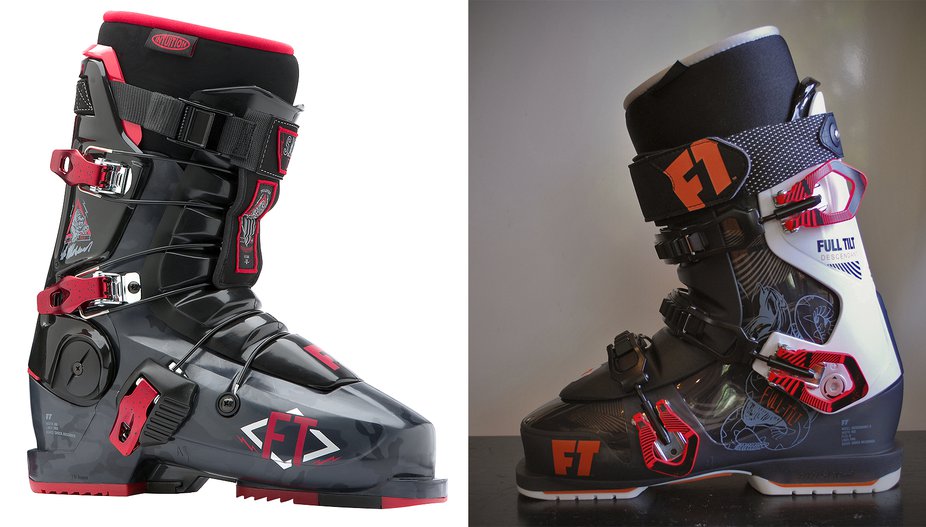
The other big change is a little less obvious to spot but if you look at the position of the second buckle on the Original boot above and then on the Descendant you may be able to spot it. On every other Full Tilt boot the second buckle is mounted to the shell just above the cuff pivot bolt. On the Descendant the buckle has been moved onto the cuff instead.
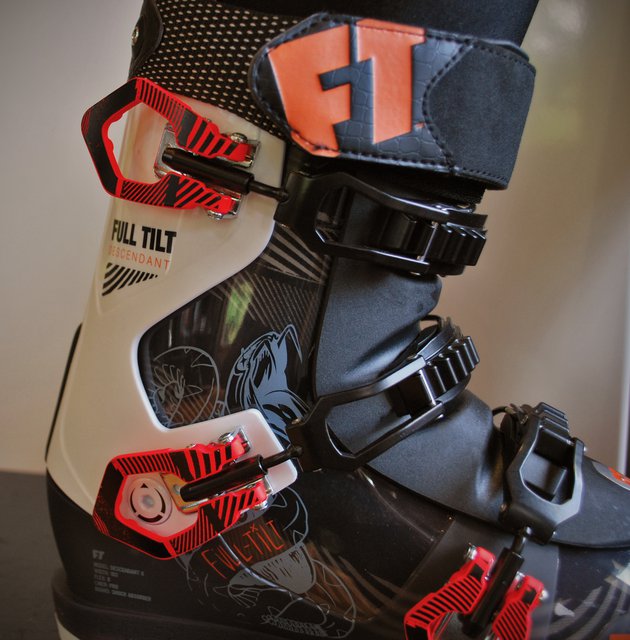
The reason for the change was to give the new boots even better heel hold. By moving the second buckle down Full Tilt were able to get a 45degree placement which should give an even better hold on the foot. By moving the buckle onto the cuff they were also able to achieve a consistent pressure. With the buckle on the shell, when the cuff flexes forward the pressure would be slightly released on the Original shell but on the Descendant the ankle hold will be consistent no matter how hard you flex the boots. This should be good for ollies and butters where you need to flex the boots hard but need a good hold on the foot.
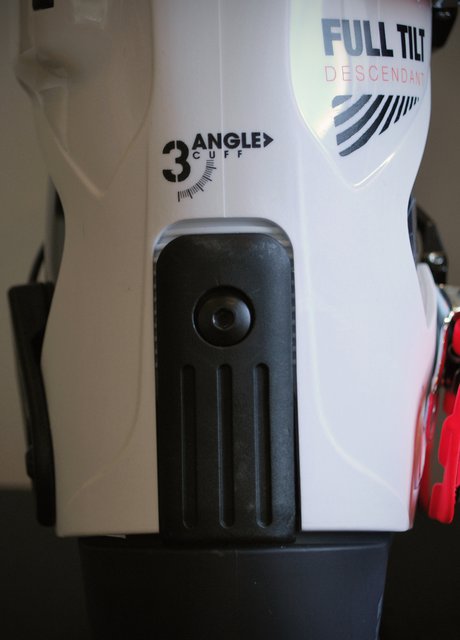
Another area the original design has been improved upon is the forward lean adjustment. On the Original shell you could change the forward lean by removing the cuff and replacing a small wedge piece. On the Descendant the forward lean is taken care of using an external backbone. You loosen the screw to release the backbone, then move the cuff to the desired forward lean and re-tighten the screw. It is a much easier way of adjusting the forward lean and is another example of how the original design concepts are still present but they have been updated and possibly improved.
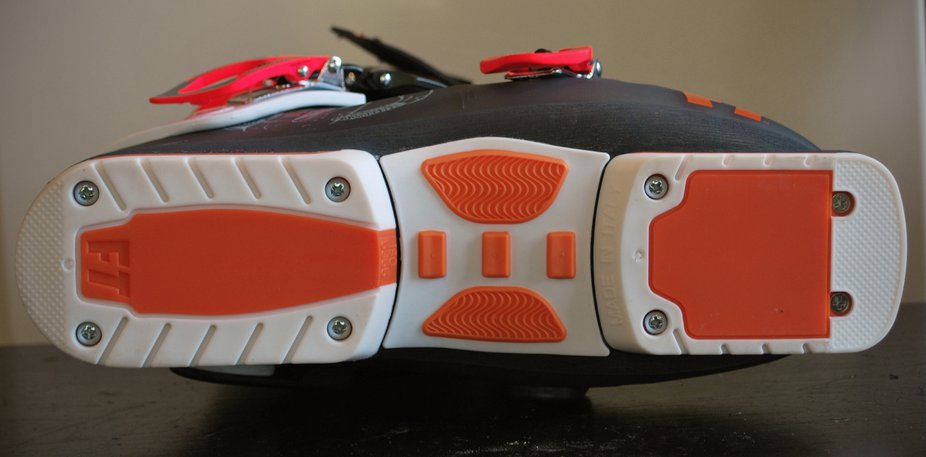
Like the Soul boots the Descendant has fully replaceable heel and toes and there is a small rubber section in the middle to help with walking. I have heard some people complain about how soft the material was on the Soul boots and I can confirm Full Tilt have used a firmer and hopefully much more durable material. I have done quite a bit of walking in the boots and so far they show very little sign of wear.
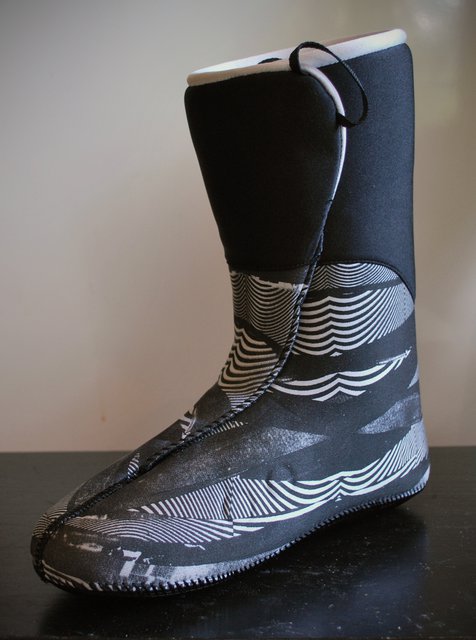
Like all their other boots Full Tilt have gone for an intuition liner, favoring a wrap style in all the Descendant boots.
So with the Descendant Full Tilt do seem to have addressed some of the issues and even improved upon the original Flexon design but is it really possible to improve such an iconic design, only one way to find out, but before that I had to fit them.
- Merchant Sale Price Retail Price
-
 Berg's Ski and Snowboard Shop $479.97 Full Tilt Descendant 8 Ski Boots - Men's
Berg's Ski and Snowboard Shop $479.97 Full Tilt Descendant 8 Ski Boots - Men's -
 Berg's Ski and Snowboard Shop $479.97 Full Tilt Descendant 8 Ski Boots - Men's
Berg's Ski and Snowboard Shop $479.97 Full Tilt Descendant 8 Ski Boots - Men's
Shop For full tilt descendant 8
- Merchant Sale Price Retail Price
-
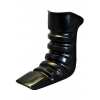 PRFO Sports $24.99 $49.99 Full Tilt Men's Ski Boot Tongue Flex 6
PRFO Sports $24.99 $49.99 Full Tilt Men's Ski Boot Tongue Flex 6 -
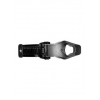 PRFO Sports $14.99 $29.99 Full Tilt Men's Wide Track Aluminium Lower Left Buckle Kit
PRFO Sports $14.99 $29.99 Full Tilt Men's Wide Track Aluminium Lower Left Buckle Kit
Shop For full tilt descendant 8
Fitting
At the time I received the boots, my entire experience with Full tilt's was about 3 runs at an indoor snowdome in the UK about 6 years ago. It was not that I disliked the way they skied, I just thought at the time there were perhaps better boots for me (mainly to do with me having wide feet) so I never really tired them again.
I first tried the boots in April and if I'm being honest initially I was not impressed and I could not see what all the fuss was about. My heel was lifting, they felt tight all over and my shins were hurting after one day. At that point I put the boots aside and got on with testing a few other pairs I had.
When I came back to them I gave them one more try and then set about fitting them.
The one best piece of advice I can give you is get the liners molded correctly. When I first tried the boots I was in a bit of a rush so only stuck the liners in the oven for 5 minutes and just put them on (no toe caps) and went skiing.
The second time around I heated up the oven for a few minutes then gave them a full 10 minutes. With the liners cooked I added my footbeds and put my foot in with a toe cap. The toe cap not only helps give the toes some room but it more importantly forces your foot back and creates a much better heel hold.
After molding the boots again they were like different boots. My heel was locked in and I began to understand what everyone loves about the boots.
Full Tilt do use slightly different sizing to most boots so you do want to be a little more careful when selecting the size. I wear a size 26 boot which will usually have a BSL of around 305-308mm. A 26 Descendant is only 300mm so I decided to instead go for the 27 which is 310mm so closer to what I am used to. Shell checking the length they were just slightly over a two finger fit so similar to most 26 boots but do make sure you try the boots before buying and don't just presume you will be the same size.
I have had to add a small heel lift in addition to my footbeds so these are certainly a high volume boot as I often struggle with boots being tight over the instep. I have had to do no shell work to the forefoot or toe and for my wide feet that is quite a rarity.
If you used to ride the SPK and like the roomy shell the Descendant may well be the boot you can finally replace your SPK's with.
Skiing 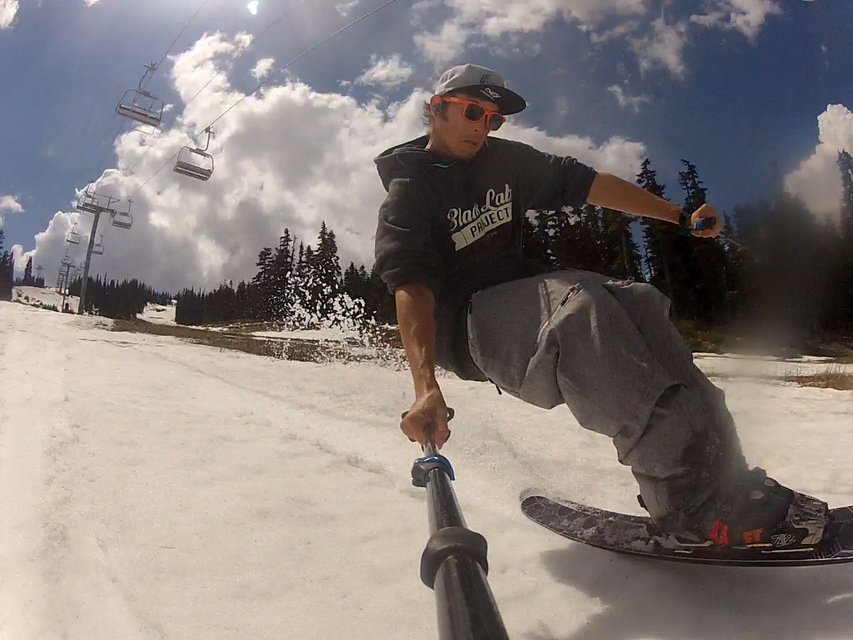
As I said my experience with Full Tilt and 3 piece boots in general is pretty limited so my first few runs were just on groomers to get an idea of the boots. The biggest difference I was initially finding compared to overlap boots was that the support the tongue felt to offer was both lower and also more forward then I was used too. I found I was more forward then I would usually be and this was causing my thighs to get slightly tired.
The forward flex itself did feel surprisingly supportive, I had heard a lot of people complain that even the stiffest tongue was too soft and after flexing the 8 tongue in the shop I did wonder if I was just going to overpower the boots but what I was forgetting was that it's progressive. Yes it feels soft initially but once you got some speed up and were putting more force through the tongue they did feel pretty good. I would probably put the 8 tongue around a 110 flex maybe a little softer so not stiff by any means but for a park boot it should be pretty good.
I did find that adjusting the forward lean to the most upright setting helped me and certainly the new method of adjusting forward lean is much easier and faster then the old method. With the boots more upright and a few more days on them I really began to enjoy the way the boots flexed. I got used to being a little more forward and I finally began to understood what people meant about loving the feel of the flex.
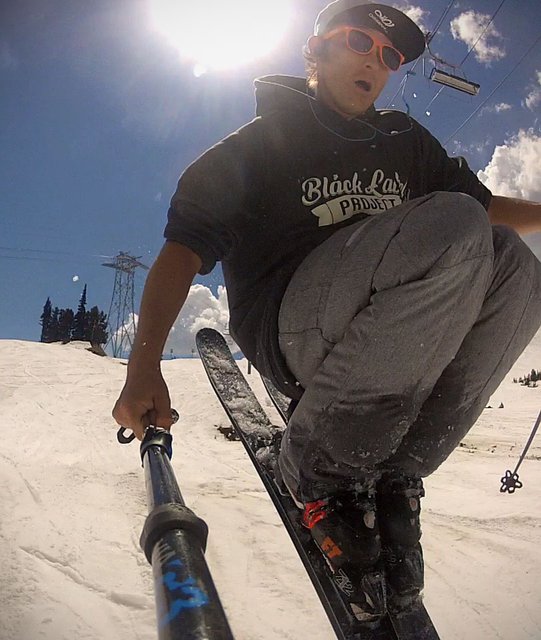
To get to the park from the Peak on whistler you have to traverse round a fairly narrow ridge. The ridge by this time of the year has some big bumps which if you hit them at speed can be pretty unforgiving. At first I was taking it easy over them as they had been hard work in my overlap boots but in the Descendant I was finding I could just hit them full speed. The flex really is one of the best I have tried for bumps and other obstacles and I can totally understand why they have been a mainstream in moguls for decades and more recently the park.
I used to think people complained to much about shin pain. I would ski park all day in a 130 Overlap and yeah by the end of the day my shins would be a little sore but I figured "hey that's skiing" but in the Descendant there really is no shin pain at all. The whole no shin bang thing I used to think was mainly marketing but having spent some time in the boots I would admit they are the comfiest flexing boots I have ever worn.
Another area the boots have absolutely shone is in impact reduction. I have been a little critical of the wrap style liner in the past as adding footbeds to a soft base will result in a less then ideal foot position but what it does offer is an amazing amount of impact reduction. Having foam under the footbed and a soft boot board gives an incredibly comfortable feel on big impacts, again probably the best I have tried. I also like that the toe box of the boot is made slightly longer then the liner so on heavy impacts there is a little space for the toes.
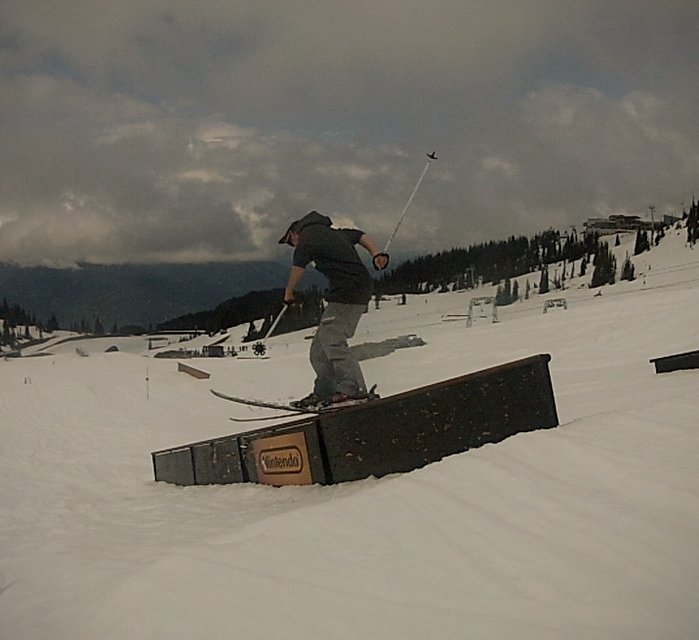
In the park I have really become a fan of the boots and I can completely understand why so many people choose to ride them. Landings are more comfortable and I still feel I have enough support from the tongue to do everything I would in a stiffer overlap boot. The comfort is I think the biggest factor, I could ski everything in the park the same I would in an overlap but the Descendant just offers more comfort, which if it does not come at the cost of performance I'm all for.
Out of the park I have not found any real problems. No they don't carve quite as hard as an overlap boot and if I was sticking to carving on firmer snow or big mountain stuff in marginal conditions I will probably still pick an overlap boot but for everything else I think they do fine. I would go for a 10 tongue for skiing out of the park but I am a fan of a stiff boot. For softer snow where there is less emphasis on digging an edge in, they will be just as good as an overlap boot and it now makes sense to me how Seth can ski the way he does in them.
The buckles have made the boots as easy to adjust as any overlap boot and I have found I can now put them on the same setting on the 2nd and 3rd buckles and leave them all day. I adjust the top as I need but pretty much I can leave the buckles and have a good fit all day.
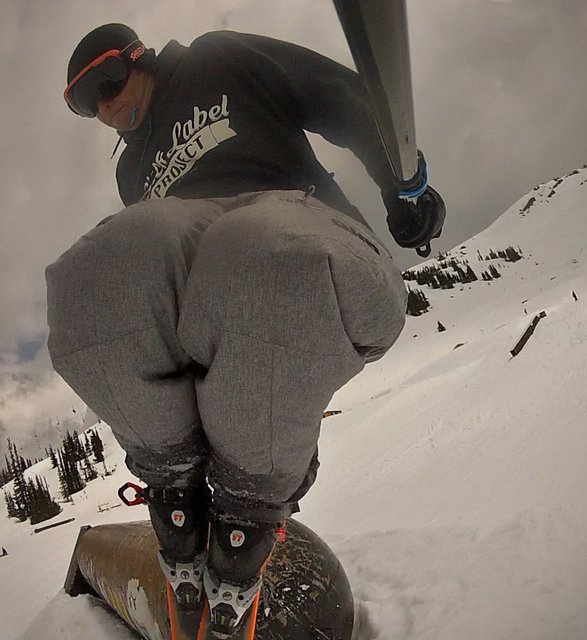
One slight issue I have found is the foot buckle does have a tendency to open quite easily. When closed the buckle does sit a fair way out from the shell and I have found when hiking the buckle would usually come open. Its not a big problem but it could lead to you damaging the buckle more easily if you have a fall with it open.
The liner once properly fitted has been great. I have always been a little dubious of how comfortable a wrap style would be, I thought the overlap would feel weird on the leg but they have actually been great. I have become a big fan of Intuition this season and although I probably do still prefer the feel of a tongue liner the wrap style does help fill the cuff volume very well as well as fitting bigger calf's which could be very useful in a wider fitting boot like this.
The liner did take more time to bed in then most which may be something Full Tilt could look at improving. Although the liner fits really well when bedded in, having it feel completely different when trying them in the shop may be holding back sales. A few brands are going to pre-shaped liners and for the most part I find these boots give a pretty good indication of fit in the shop and for the most part these are the boots that are selling well.
In terms of durability I really have not spent enough time on them to really test this out but so far I have had no issues at all. One of the things most people have said when they look at the boots is "Wow they don't look like they will break" although maybe a little harsh to full tilt it does at least show that the boots at least seem more durable.
I could see if you are a heavier skier or if your tall then you may find that you want more support from the cuff and tongue but I must admit I am pretty much sold on the boots which going into this test, as open minded as I try to be, I did not expect.
Comparing to Overlap
Initially I was going to compare the boots to the Original shell but after skiing both really they feel very similar. If you are in the Original or Soul now and you could do with a wider fit you should have no hesitations about switching to the Descendant.
What I thought would perhaps be more interesting would be to compare them to overlap boots and see if I could really notice the difference.
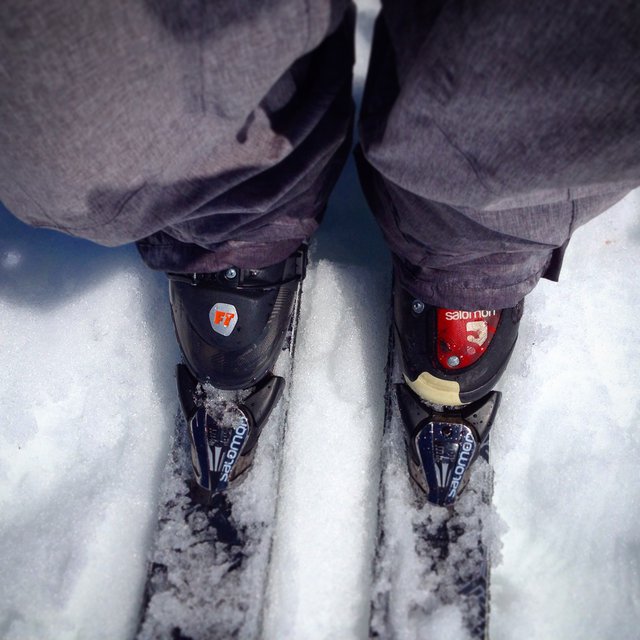
The boot I choose to compare to the Descendant will probably be very familiar to a lot of you. The SPK form Salomon was for many years the go to park boot for people with wider feet. I myself used them for 6 years and if you look in the parks today you will still see plenty of pairs.
Newschoolers very own Mr Bishop is skiing in a pair of the White SPK Pro's from 2008 and I asked him what it was about the SPK he loved so much
Mr Bishop: The SPK boots are bar none the single most comfortable boot I have ever had on my foot. I have incredibly wide feet, and before I discovered them every boot I ever tried was absolute miserable hell. The biggest reason I still wear them is simply their exceptional fit.
Now having said that, I also love that they are an incredible park boot. The more upright stance as well as the shock absorbing are incredible features. The stance is something you really notice going switch if you are doing that a lot, so between the comfort and the specific performance tailored to my park roots - there has never been a boot that I have loved as much as the SPK Pro
That sentiment is matched by many other skiers and when Salomon discontinued the SPK last season in favor of the Ghost FS ( a very good boot just not the same wide fit at all) many were left wondering what they were going to get next.
In my opinion the Descendant is that SPK replacement.
I did a few runs with one on each foot and found there were a lot of similarities. The stiffness felt pretty identical (the spk has a flex of 100) and the fit was also very similar. One of the best features on the SPK was the rubber toe but the Descendant offered just as much comfort even without the rubber section. The forward lean was similar, remember I had made the Descendant more upright, but interestingly the SPK felt stiffer rearwards. Normally I like a boot to be stiff there but I was actually finding it was throwing me off a little. The Descendant does seem to give a slightly more forgiving rearward flex mainly due i suspect to it not having the cuff bolted. Buttering and landing backseat was actually far more effective and more comfortable in the Descendant.
The main difference really was the feel of the flex. Trying both side by side really did show how effective and comfortable the flex is on the Descendant. I was getting pressure over the instep on the SPK as the cuff hit the shell and it just in general did not feel as good. The lateral stiffness was fairly similar but I can see why people would prefer an overlap boot if you really like to lean into the boots.
An overlap cuff is more supportive and if anything trying them side by side did make me wonder whether even with a 10 tongue they would be stiff enough for me out of the park. The SPK was great but certainly not a charger so with the 8 tongue feeling the same I think I may find even the 10 a little soft for how I normally ski.
It does also make me wonder who actually skis the 4 tongue. Full Tilt are making the Descendant in a 4,6 and 8 tongue version and personally I would have liked 6,8 and10 instead where the 10 is a little beefed up and a little more freeride, but hey this is the first year.
But apart from that honestly there is no competition. If you like the way the SPK fits and skis you will love the Descendant.
Overall
This has been quite an eye opening test for me. I never really believed all the hype but in this case it is actually for the most part justified.
If you already like the feel of a 3 piece boot but you need a wider fit then these are for you. The improvements if anything have taken them beyond the Original and Soul boots, so really you are lucky in a way if you have wide feet.
As far as my park riding goes I certainly see myself riding Full Tilts quite a bit but I will have to see how they fair for me out of the park. I think for the more aggressive riding I do, I probably will still choose an overlap boot, I would love to try some Seths's maxed out with the stiffest tongue though, and obviously for backcountry and touring I will still choose other boots but I really am sold of the flex and feel of the boots and I will certainly be experimenting more with them and really seeing what they can do.
There are a few little areas which could perhaps be improved. The toe buckle I do see being an issue. Having it open so easily will lead to people damaging them, but it should be an easy fix if it turns out to be an issue. Perhaps switching it so the buckle sits on the tongue would work better or perhaps better would be if full tilt could find a way to make a buckle with a bend. The teeth latch could sit where it does now but instead of having the buckle go straight down perhaps it could sit more at a 45degree angle, hopefully preventing it from opening so easily.
The other area I think could be, not so much improved but more developed would be to make the boots stiffer. As I have said repeatedly the flex is pretty much as close to perfect as you can get but it perhaps is not as supportive as it could be.
The hard part is stiffening without loosing the natural flex. My proposal is pretty simple, make the tongue about 2 inches higher and add a second buckle on the cuff. You can keep the ridged tongue but having two buckles side by side on the top of the cuff and the new 45degree buckle would in my opinion offer a more supportive feel without loosing the natural flex. I would love to see Full Tilt gain traction throughout the ski industry again just as Raichle did back in the day. Just imagine a 200lbs downhiller stood in the Olympic start gate in a pair of Full Tilts. No I don't think it will happen but they have one Gold in DH before so you never know.
Now I'm sure all these things have been tried and they probably don't work, hence why we don't see them but I figure its always good to think what else can be done.
One area which might be quite interesting in the future is the new Backbone. You may wonder why that is exciting but having an external backbone does potentially mean a Hike/Walk boot could be developed. A 3 piece touring boot in my opinion could be pretty awesome. Many overlap freeride boots suffer from not adequately being able to lock the cuff when in ski mode, but Full Tilt wont have this issue. The free floating cuff is perfect for a hike boot as all they need does is release the flex rearwards. They are also already setup to remove and replace the tongue, like a lot of touring boots use make walking easier. You could perhaps put in a 2 flex tongue to hike up but then replace that with whatever you normally use when you are ready to ski.
I have no idea if Full Tilt are working on any other new boots but looking at what they have done with the Descendant I see the potential for quite a few changes throughout the line and also maybe some more new boots.
But even if no new boots come from this, Full Tilt now do have a very capable wide fitting boot something they could not truly say in the past.
So perhaps now the old "just get full tilts" is actually good advice.
Review System
I know there are a ton of you out there wearing full tilts and I also know there are many out there who have some pretty strong views, good and bad. Well we want to hear those views, add them all to the review system. You don't even need to type if you don't want, you can submit a review simply by moving the sliders. The more of you that submit reviews the better it works for everyone so go in and add your thoughts.
Here are a few of my reviews of other products I was testing alongside the Descendants.
Black Label Project Vintage Hoodie
You may not have heard of BLP yet but you will. They are a small UK company making some very high quality gear, check them out.
These shell pants from Eira were the perfect spring riding pant
Dissent Ski Genuflex Compression Full Protect Sock
Yes they have the longest names in the world but they are also in my opinion the very best socks you can buy
The skis I was using in this test were the RMU Wisco and I have a full review coming soon so whatch out for that.
Thanks to Jason for talking the time to answer my questions and if you want to know more about Jason check out his site here and thanks to Josh from Full Tilt.
www.fulltiltboots.com
To keep up to date with what I'm testing follow me on Instagram @tompietrowski

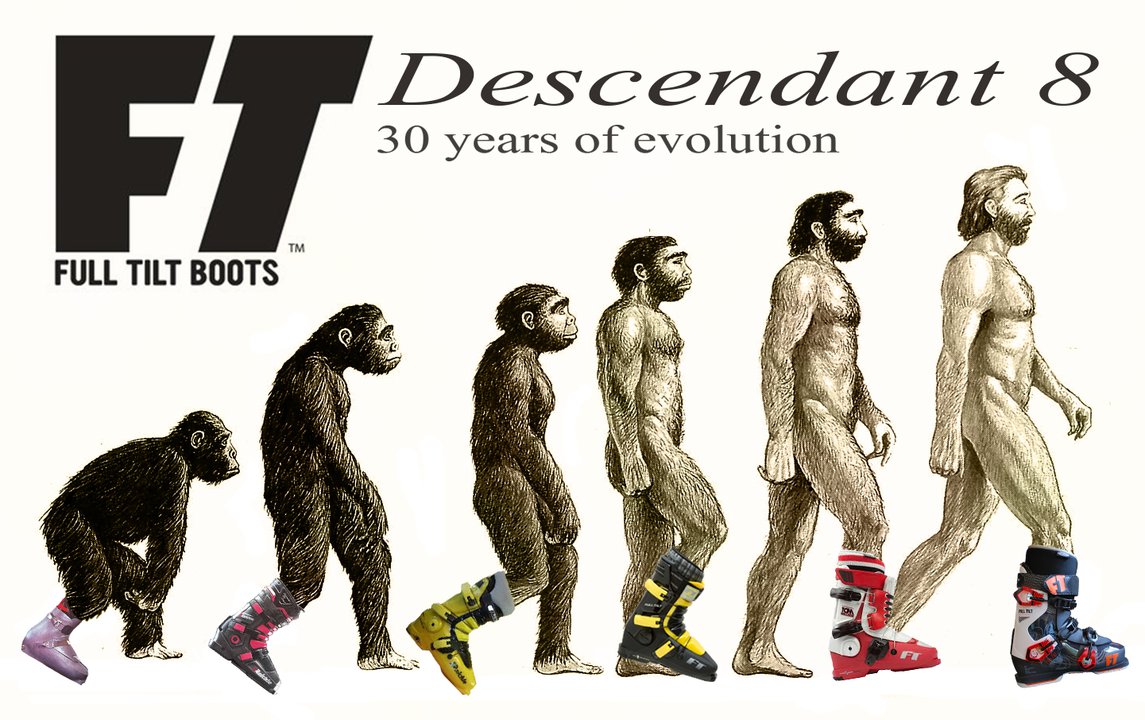


Comments